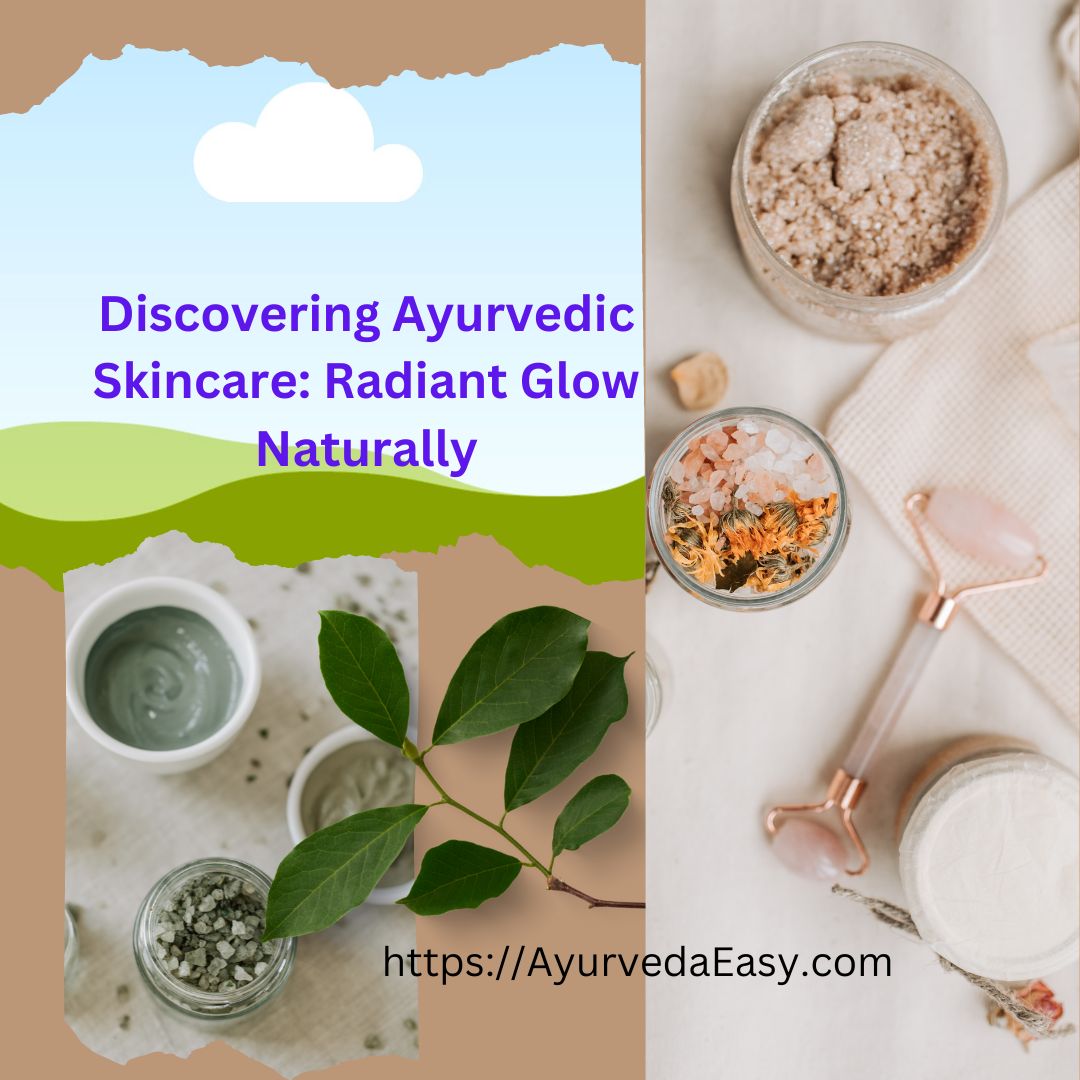Discovering Ayurvedic Skincare: Radiant Glow Naturally
Ayurveda, an ancient system of holistic healing, transcends mere medical practices, embodying a philosophy that integrates mind, body, and spirit. Rooted in the wisdom of ancient Indian scriptures, Ayurveda places emphasis on achieving balance within the body’s unique constitution, known as doshas. These doshas, Vata, Pitta, and Kapha, represent distinct energies governing various physiological and psychological functions.
Table of Contents
ToggleIn the realm of Ayurveda, skincare is not merely a superficial endeavor but a reflection of one’s inner balance. The skin, being the body’s largest organ, mirrors the state of our internal equilibrium. Ayurvedic skincare, therefore, is an extension of the holistic principles that define Ayurveda, advocating for a harmonious existence within oneself and with the natural world.
The connection between Ayurveda and skincare lies in the belief that radiant, healthy skin is a result of internal balance. When the doshas are in harmony, the skin reflects vitality and resilience. As we delve into the realms of Ayurvedic skincare, we uncover timeless rituals and remedies that not only nurture the skin but also foster a deeper connection to our own well-being. Join us on a journey to discover the profound intersection of Ayurveda and the pursuit of naturally radiant skin.
Ayurvedic Principles for Skincare
Ayurveda, the ancient science of life, unveils a profound understanding of our individual constitution through the concept of doshas—Vata, Pitta, and Kapha. These doshas, representing the elemental forces of space and air (Vata), fire and water (Pitta), and earth and water (Kapha), govern the intricate dance of energies within our bodies and minds.
Understanding the Doshas and Skin Types:
Each dosha imparts distinct qualities to our skin, shaping its texture, resilience, and overall health. Vata, driven by air and space elements, is associated with dryness, leading to skin that may feel rough or dehydrated. Pitta, influenced by fire and water, manifests in sensitive, inflammatory skin that may be prone to redness and irritation. Kapha, rooted in earth and water, governs skin characterized by oiliness and congestion, potentially leading to issues like excess sebum production and clogged pores.
By recognizing the dominant dosha within oneself, individuals can gain insights into their skin type and tailor their skincare routines accordingly. This personalized approach allows for targeted care that addresses specific needs, promoting optimal skin health.
Balancing Doshas for Enhanced Skin Health:
The essence of Ayurvedic skincare lies in the art of balancing these doshas, fostering equilibrium within the body and mind. When doshas are harmonized, the skin reflects a natural luminosity and resilience. Ayurveda advocates for a holistic approach that extends beyond external remedies, emphasizing lifestyle, diet, and mindful practices to restore balance.
Vata Balancing:
For those with a predominant Vata constitution, hydrating and nourishing skincare routines are crucial. Incorporating warm oils, like sesame or almond, helps combat dryness and promotes a sense of grounding. Additionally, practicing mindfulness and adopting a calming lifestyle aids in pacifying Vata, reflecting positively on the skin’s texture and vitality.
Pitta Pacification:
To address Pitta-related skin concerns, a cooling and soothing approach is key. Gentle, fragrance-free skincare products can help alleviate sensitivity, while incorporating anti-inflammatory ingredients such as aloe vera and chamomile can calm redness and irritation. Balancing Pitta also involves managing stress through practices like meditation, contributing to a serene complexion.
Kapha Harmonization:
Kapha-dominant skin benefits from invigorating and detoxifying rituals. Regular exfoliation with natural scrubs helps prevent clogged pores, while incorporating light, non-comedogenic oils maintains balance. Engaging in energizing activities and maintaining an active lifestyle assists in preventing the stagnation often associated with Kapha imbalances, promoting a clearer and more vibrant complexion.
In essence, Ayurvedic skincare transcends generic beauty routines, providing a tailored approach that aligns with the unique constitution of each individual. By embracing the wisdom of dosha balancing, we embark on a transformative journey toward not only radiant skin but also holistic well-being.
Ayurvedic Ingredients for Radiant Skin
In the realm of Ayurvedic skincare, the alchemy of nature unfolds through a treasure trove of potent ingredients. Among them, turmeric, neem, and aloe vera emerge as stars, each offering unique benefits that cater to diverse skin types and concerns.
Turmeric: The Golden Elixir of Radiance
Turmeric, often referred to as the golden spice, boasts a rich history deeply intertwined with Ayurveda. Its active compound, curcumin, possesses potent anti-inflammatory and antioxidant properties. For Vata-prone skin, turmeric’s warming qualities provide nourishment and hydration, combating dryness. In Pitta-dominant skin, its cooling effects help soothe irritation and reduce redness. Meanwhile, for Kapha-influenced skin, turmeric’s detoxifying nature aids in controlling oiliness and promoting a clear complexion. Incorporating turmeric into skincare rituals not only imparts a natural radiance but also addresses a spectrum of skin imbalances.
Neem: The Purifying Essence
Neem, hailed as the “village pharmacy” in Ayurveda, is a powerful purifier with antibacterial, antifungal, and anti-inflammatory properties. Ideal for Pitta-related skin concerns, neem calms inflammation and aids in healing blemishes. Its natural astringency benefits oily Kapha skin, helping to regulate sebum production and prevent breakouts. In Vata-prone skin, neem’s hydrating properties provide relief from dryness, making it a versatile ingredient that brings clarity and balance to a variety of skin types.
Aloe Vera: The Cooling Hydration Miracle
Aloe vera, known for its soothing and hydrating qualities, is a universal elixir in Ayurvedic skincare. Its cooling nature makes it especially beneficial for Pitta-driven skin, offering relief from sensitivity and sun-induced irritation. For Kapha skin, aloe vera’s light texture hydrates without clogging pores, providing a refreshing boost. Vata skin benefits from its moisturizing properties, combating dryness and promoting a supple complexion. Whether in the form of gel or juice, aloe vera stands as a versatile ally for those seeking a naturally radiant and well-nourished visage.
Tailoring Ayurvedic Ingredients to Skin Types:
The beauty of Ayurvedic skincare lies in its adaptability to diverse skin needs. Understanding these key ingredients allows individuals to tailor their skincare routines for optimal results.
- For Dry and Vata Skin: Turmeric’s warmth and aloe vera’s hydration form a nourishing duo, combating dryness and promoting a radiant glow.
- For Sensitive and Pitta Skin: Neem’s calming properties, combined with aloe vera’s soothing touch, create a gentle yet effective regimen for sensitive skin.
- For Oily and Kapha Skin: Turmeric’s detoxifying qualities, complemented by neem’s purifying action, help regulate oil production and maintain a clear complexion.
In essence, Ayurvedic skincare transcends one-size-fits-all solutions, offering a nuanced approach that aligns with individual skin types. By harnessing the potency of turmeric, neem, and aloe vera, one can embark on a journey towards radiant skin that mirrors the harmony found in the natural world.
Daily Ayurvedic Skincare Routine
Embarking on a daily Ayurvedic skincare routine is akin to nurturing a sacred ritual that honors the balance of mind, body, and spirit. Both morning and evening routines play a pivotal role in achieving and maintaining vibrant, healthy skin. The key lies not only in the choice of Ayurvedic ingredients but also in the intention and mindfulness with which these rituals are approached.
Morning Routine:
Wake Up Mindfully:
Begin your day with gratitude, acknowledging the gift of a new day. Connect with your breath through a few moments of deep breathing or meditation.
Cleanse with Herbal Infusions:
Gently cleanse your face with a mild, herbal cleanser infused with ingredients like neem or rose water. This helps remove overnight impurities without stripping the skin of its natural oils.
Hydrate with Rosewater:
Spritz your face with rosewater, a soothing and hydrating step that prepares the skin for subsequent products. Rosewater helps balance Pitta and refresh the complexion.
Apply Dosha-Specific Serum:
Choose a serum tailored to your dosha type. For Vata skin, opt for nourishing ingredients like ashwagandha. Pitta skin benefits from cooling serums with aloe vera, while Kapha skin thrives on invigorating blends.
Sunscreen Ritual:
Protect your skin with a natural sunscreen infused with Ayurvedic herbs. This shields the skin from harmful UV rays while embracing the wisdom of Ayurveda’s preventative approach.
Evening Routine:
Mindful Transition:
As the day concludes, transition into your evening routine with mindful awareness. Release the day’s stresses through a short meditation or breathing exercise.
Cleansing Ritual:
Cleanse your face thoroughly to remove accumulated pollutants and makeup. Consider using a cleansing oil with sesame or almond oil for Vata balance or aloe vera for Pitta soothing.
Ayurvedic Face Mask:
Once or twice a week, indulge in an Ayurvedic face mask. For Vata skin, opt for hydrating masks with honey and turmeric. Pitta skin benefits from cooling masks with cucumber and mint, while Kapha skin thrives on detoxifying clay masks.
Night Routine:
Nourishing Night Cream:
Apply a dosha-specific night cream enriched with ingredients like ghee for Vata, chamomile for Pitta, or neem for Kapha. This nourishes the skin as it rejuvenates during the night.
Reflect and Relax:
Before bedtime, take a moment to reflect on the day. Engage in relaxing activities like reading or gentle stretches to unwind and prepare for a restful sleep.
Consistency and Mindfulness:
Consistency is the cornerstone of an effective Ayurvedic skincare routine. By incorporating these steps into your daily and nightly rituals, you not only provide your skin with consistent care but also cultivate a mindful connection with your own well-being. Ayurveda emphasizes that the intention behind each step, coupled with regularity, enhances the transformative power of these practices. In the tapestry of Ayurvedic skincare, the threads of consistency and mindfulness weave together to reveal the radiant canvas of holistic beauty.
Ayurvedic Diet for Healthy Skin
In the profound realm of Ayurveda, the connection between nutrition and skin health is viewed as an inseparable synergy. The ancient wisdom encapsulated in Ayurvedic principles recognizes that radiant skin is not merely a result of external treatments but is deeply influenced by the nourishment we provide from within. The Ayurvedic approach to skincare extends beyond topical remedies, emphasizing a holistic understanding that our dietary choices play a pivotal role in achieving and maintaining healthy skin.
Understanding the Connection:
According to Ayurveda, the three doshas—Vata, Pitta, and Kapha—not only govern our physiological and psychological functions but also profoundly influence our dietary needs. The key lies in achieving a balance within these doshas, as an imbalance can manifest in various skin issues. A well-balanced diet, tailored to individual dosha constitutions, becomes a cornerstone in promoting skin health from the inside out.
Dietary Recommendations Based on Dosha Balance:
Vata-Pacifying Diet:
Emphasize warm, nourishing foods to counter Vata’s dry and cold qualities.
Include cooked grains, root vegetables, and warming spices like ginger and cinnamon.
Healthy fats from sources like ghee and sesame oil provide essential lubrication for dry Vata skin.
Pitta-Balancing Diet:
Opt for cooling and hydrating foods to alleviate Pitta’s heat and inflammation.
Incorporate sweet, bitter, and astringent tastes found in fruits, leafy greens, and whole grains.
Avoid spicy and acidic foods that may exacerbate Pitta-related skin issues.
Kapha-Harmonizing Diet:
Focus on light and easily digestible foods to counter Kapha’s heaviness and congestion.
Include a variety of vegetables, legumes, and warming spices like black pepper and turmeric.
Limit intake of heavy, oily foods to prevent clogging and stagnation in Kapha skin.
By aligning dietary choices with Ayurvedic principles, individuals can address not only their skin concerns but also nurture overall well-being. The Ayurvedic diet for healthy skin serves as a profound testament to the interconnectedness of mind, body, and spirit, emphasizing that true radiance emanates from a harmonious balance within.
Ayurvedic Practices for Skin Issues
In the holistic landscape of Ayurveda, addressing common skin problems like acne, dryness, and inflammation is approached with a deep understanding of individual constitution and elemental imbalances. Ayurvedic solutions not only target the symptoms but aim to restore overall balance within the body, reflecting in the skin’s natural radiance.
Common Skin Problems and Ayurvedic Solutions:
Acne:
Ayurveda attributes acne to excess Pitta, emphasizing the need to cool and purify the blood.
Herbal remedies like neem and turmeric are employed for their antibacterial and anti-inflammatory properties.
Internal detoxification through dietary adjustments and herbal supplements aids in Pitta pacification.
Dryness:
Vata imbalance often leads to dry skin, and Ayurveda focuses on nourishing and hydrating practices.
External application of warm sesame oil, infused with herbs like ashwagandha, helps combat dryness.
Internal hydration through increased water intake and consumption of moisturizing foods like avocados supports Vata-balancing efforts.
Inflammation:
Inflammation is commonly associated with excess Pitta, and Ayurvedic practices aim to cool and soothe.
Aloe vera, sandalwood, and cooling herbal teas like mint are recommended to reduce inflammation.
Pitta-balancing dietary adjustments, avoiding spicy and heating foods, contribute to long-term relief.
DIY Ayurvedic Skincare Recipes:
Turmeric Face Mask for Acne:
- Mix 1 teaspoon of turmeric powder with a tablespoon of honey and a few drops of rose water.
- Apply the paste to the affected areas, leaving it on for 15-20 minutes before rinsing.
Sesame Oil Infusion for Dry Skin:
- Warm sesame oil and add a pinch of ashwagandha powder.
- Massage this blend onto dry skin before bathing, allowing the nourishing properties to seep in.
Cucumber Mint Cooling Toner for Inflammation:
- Blend cucumber and mint leaves, strain the juice, and mix with rose water.
- Apply this refreshing toner to calm inflamed skin and restore balance.
These DIY recipes showcase the simplicity and efficacy of Ayurvedic skincare, utilizing natural ingredients to address specific skin concerns while maintaining the body’s equilibrium. The integration of Ayurvedic practices offers a profound and sustainable approach to achieving not just external beauty but holistic well-being.
Ayurveda and Modern Skincare
The ancient wisdom of Ayurveda seamlessly intertwines with modern skincare, creating a harmonious fusion that acknowledges tradition while embracing technological advancements. The intersection of traditional Ayurveda and contemporary skincare is a testament to the enduring relevance of Ayurvedic principles in the pursuit of healthy, radiant skin.
Exploring the Intersection:
Modern skincare has increasingly turned to Ayurvedic principles to harness the power of natural ingredients and holistic practices. Ayurvedic herbs such as turmeric, neem, and aloe vera have become staples in many skincare formulations. The recognition of individual skin types, a core tenet of Ayurveda, has influenced the rise of personalized skincare routines and products tailored to specific needs. Brands now emphasize the importance of balancing doshas and creating inclusive products that cater to a diverse range of skin types.
Ayurvedic Practices in Modern Beauty Brands:
Dosha-Specific Products:
Brands are now formulating products designed for specific dosha types, acknowledging that a one-size-fits-all approach may not cater to the unique needs of each individual. This customization aligns with Ayurvedic teachings, where balance is achieved by addressing the unique constitution of an individual.
Incorporation of Ayurvedic Ingredients:
The popularity of Ayurvedic ingredients like turmeric, neem, and aloe vera has surged in modern skincare formulations. These ingredients, known for their healing and nourishing properties in Ayurveda, are now celebrated for their efficacy in addressing various skin concerns in contemporary beauty products.
Mindful Skincare Rituals:
Ayurveda places great importance on mindfulness, and this philosophy has seeped into modern skincare practices. Brands now emphasize the ritualistic aspect of skincare, encouraging individuals to approach their routines with intention and mindfulness, creating a holistic experience beyond the tangible benefits for the skin.
Conclusions
In the symphony of Ayurvedic skincare, the journey towards natural radiance is not just a pursuit of external beauty but a profound alignment with the timeless principles of holistic well-being. The exploration of Ayurvedic practices, from understanding doshas and incorporating key ingredients to crafting daily rituals, unveils a path that transcends trends and embraces the inherent wisdom of nature.
As we navigate the bustling landscape of modern skincare, the intersection of traditional Ayurveda with contemporary beauty brands stands as a testament to the enduring relevance of ancient principles. Dosha-specific products, the infusion of Ayurvedic ingredients, and the emphasis on mindful skincare rituals showcase a harmonious blend of tradition and innovation, creating a bridge that connects the past with the present.
Key Takeaways:
- Holistic Approach: Ayurveda advocates a holistic approach to skincare that considers internal balance, lifestyle, and diet alongside topical treatments.
- Personalization: Recognizing and catering to individual skin types is a pivotal aspect of both traditional Ayurveda and modern skincare.
- Power of Natural Ingredients: Ayurvedic ingredients are revered for their natural healing properties and are now integral to many skincare products.
Encouragement to Embrace Ayurvedic Principles:
As we navigate the complexities of skincare in the modern world, embracing Ayurvedic principles becomes a pathway to a natural and radiant glow. By incorporating dosha-balancing practices, choosing products with Ayurvedic ingredients, and adopting a mindful skincare routine, individuals can embark on a transformative journey towards holistic well-being and beauty. Ayurveda not only offers a timeless guide to skincare but also invites us to reconnect with the profound wisdom of nature in our quest for radiant and healthy skin.
In the canvas of Ayurvedic skincare, where turmeric and neem meet modern serums, and daily rituals intertwine with the rhythm of life, the invitation is clear. Embrace Ayurvedic principles with consistency and mindfulness, for in doing so, you embark on a journey towards a radiant and natural glow that mirrors the harmonious balance found in the interconnected realms of mind, body, and spirit. As the ancient teachings of Ayurveda whisper through every skincare ritual, they echo the timeless truth that beauty, when rooted in balance and authenticity, radiates from within.




